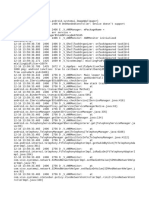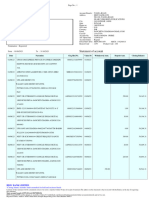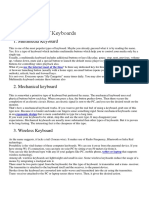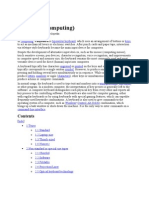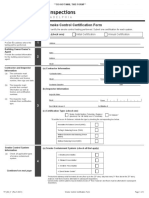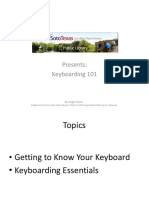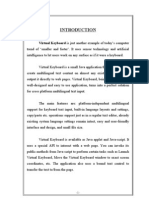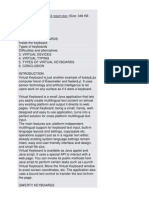04 Chapter 04 - Input Devices - Part I
Uploaded by
The Shield04 Chapter 04 - Input Devices - Part I
Uploaded by
The ShieldChapter 4
Input Devices
1
Outline
• Standard methods of input
– Keyboard
– Pointing Devices
• Alternative methods of input
– Imaging and Video Input Devices
– Audio Input Devices
Standard Methods of Input
- Keyboard
• Types of Keyboard
• Keyboard Layout
• Key Types
• How a Keyboard Works
Keyboard
• The keyboard looks very similar to the
keyboards of electric typewriters, with some
additional keys.
• Keyboards allow a computer user to input
letters, numbers, and other symbols into a
computer.
• Uses an arrangement of buttons or keys.
• Requires pressing and holding several keys
simultaneously or in sequence.
4
Keyboard
5
Types of Keyboard
• Standard
• Laptop
• Gaming and Multimedia
• Thumb-sized
• Virtual
• Foldable
• Ergonomic
6
Types of Keyboard
Standard Keyboard
• Desktop computer keyboards, such as the
101-key US traditional keyboards, the 104-
key Windows keyboards or the 109-key
Apple keyboards with numeric keypad,
include alphabetic characters, punctuation
symbols, numbers and a variety of function
keys.
Types of Keyboard
Laptop Keyboard
• The laptop computer keyboard is a small
version of the typical QWERTY keyboard.
• A typical laptop has the same keyboard type
as a normal keyboard, except for the fact
that most laptop keyboards condense the
symbols into fewer buttons to accommodate
less space.
Types of Keyboard
Gaming and Multimedia Keyboard
• The gaming keyboards are designed for the
convenience of the gamers and these types of
keyboards provide the required controls on
the keyboards like back lighting.
9
Types of Keyboard
Thumb -sized keyboard
• Smaller external keyboards have been
introduced for devices without a built-in
keyboard, such as PDAs, and smartphones.
• Small keyboards are also useful where there
is a limited workspace.
10
Types of Keyboard
Virtual keyboard
• The virtual keyboards are not actually
physical keyboards, but they are
simulated using a software.
11
Types of Keyboard
Foldable keyboard
• Foldable keyboards are extremely good for
travelling.
• Simply roll them up and then unroll them
when you need them again.
12
Types of Keyboard
Ergonomic Keyboards
• Long periods of keyboard use can cause
injuries. An ergonomically correct keyboard
can help you avoid injuries. You also can avoid
injuries by adopting correct keyboarding
practices.
Keyboard Layouts
• QWERTY
• QWERTZ
• AZERTY
• DVORAK
Keyboard Layouts
QWERTY
• Common layout
Keyboard Layouts
QWERTZ
• Used in Germany, Hungary and Czech Republic.
Keyboard Layouts
AZERTY
• It is used by most French speakers based in
Europe.
Keyboard Layouts
DVORAK
• Alternative for QWERTY.
• Dvorak layout uses less finger motion, increases
typing rate, and reduces errors compared to
the standard QWERTY.
Key Types
Key Type Example
Alphanumeric A-Z, 0-9
Punctuation .,!“?
Shift, Space Bar, Enter, Ctrl,
Modifiers
Alt
Navigation Arrows, Home, Page Up
System Command PrtScn, Esc, F1, Start
19
Key Types
Function keys
• The Function keys or F1 through F12 keys are
used in programs as shortcut keys to
performed frequently performed tasks.
• For example, the F1 key is the key to open
the online help for most programs.
20
Key Types
Control keys
• The Control keys are what give you additional
control of a document.
21
Key Types
Keypad
• Although not available on all computer
keyboards, especially laptops; the keypad
gives the user a quick access to numbers and
math functions such as plus, divide, times,
and subtract.
22
Key Types
Arrow keys
• The arrow keys are four directional arrow
keys that allow the user to move their cursor
and position on a page.
23
Keyboard Shortcut Keys
Shortcut Keys Description
Alt + F File menu options in current program
Alt + E Edit options in current program
F1 Universal Help in almost every Windows program
Ctrl + A Select all text
Ctrl + X Cut selected item
Shift + Del Cut selected item
Ctrl + C Copy selected item
Ctrl + Ins Copy selected item
Ctrl + V Paste
Shift + Ins Paste
Ctrl + P Print the current page or document
Home Goes to beginning of current line
Ctrl + Home Goes to beginning of document
End Goes to end of current line
Ctrl + End Goes to end of document
Shift + Home Highlights from current position to beginning of line
Shift + End Highlights from current position to end of line
Ctrl + Left arrow Moves one word to the left at a time
24
Ctrl + Right arrow Moves one word to the right at a time
Keyboard - How a Keyboard Works
When you press a key:
• The keyboard controller detects the keystroke.
• The controller places a scan code in the keyboard
buffer, indicating which key was pressed.
• The keyboard sends the computer an interrupt
request, telling the CPU to accept the keystroke.
You might also like
- 000 2173rb Ts 550 - 5000 Evo Programming PDFNo ratings yet000 2173rb Ts 550 - 5000 Evo Programming PDF54 pages
- Alday.J Canderalrio.D Mendoza.J Javina.M 1 PDFNo ratings yetAlday.J Canderalrio.D Mendoza.J Javina.M 1 PDF18 pages
- Engenharia Controle Moderno, Katsuhiko Ogata, 3a Edicao, Versao Digital PDFNo ratings yetEngenharia Controle Moderno, Katsuhiko Ogata, 3a Edicao, Versao Digital PDF828 pages
- XINJE User Manual-do-Hardware-CLP-XINJE-XD-XLNo ratings yetXINJE User Manual-do-Hardware-CLP-XINJE-XD-XL139 pages
- Explosion Light & Fittings Brochure 2023No ratings yetExplosion Light & Fittings Brochure 202323 pages
- Nama: Randi Padilah Nim: 20200810062 Class: TINFC-2020-01No ratings yetNama: Randi Padilah Nim: 20200810062 Class: TINFC-2020-015 pages
- Synthesis and Characterization of LiFePO4CNT Composites With Variation of Calcination Time As Battery CathodeNo ratings yetSynthesis and Characterization of LiFePO4CNT Composites With Variation of Calcination Time As Battery Cathode3 pages
- PowerShell Optimization and Performance TestingNo ratings yetPowerShell Optimization and Performance Testing3 pages
- EEXI Regulation Compliance (Introduction of EEXI-EPL SystemNo ratings yetEEXI Regulation Compliance (Introduction of EEXI-EPL System10 pages
- Howstuffworks - How Computer Keyboards WorkNo ratings yetHowstuffworks - How Computer Keyboards Work34 pages
- Ocp 100-Introduction To Microcomputer Studies and Information Technology88% (8)Ocp 100-Introduction To Microcomputer Studies and Information Technology4 pages
- FM 200 System Installations, Testing and Commissioning. Contract Name100% (1)FM 200 System Installations, Testing and Commissioning. Contract Name16 pages
- Lesson 3 Insert Keyboarding Skills Keyboard ShortcutsNo ratings yetLesson 3 Insert Keyboarding Skills Keyboard Shortcuts24 pages
- StreamCaster - 4200P SC4200 Plus Drop in Module DatasheetNo ratings yetStreamCaster - 4200P SC4200 Plus Drop in Module Datasheet2 pages
- 8 Different Types of Keyboards Available in The MarketNo ratings yet8 Different Types of Keyboards Available in The Market5 pages
- Keyboard (Computing) : From Wikipedia, The Free EncyclopediaNo ratings yetKeyboard (Computing) : From Wikipedia, The Free Encyclopedia24 pages
- Computer Operations and Fundamentals:: The KeyboardNo ratings yetComputer Operations and Fundamentals:: The Keyboard41 pages
- Keyboard and Mouse: Functions and Types Keyboard MouseNo ratings yetKeyboard and Mouse: Functions and Types Keyboard Mouse5 pages
- Smoke Control Certification Form: Indicate Certification Year: (Check One)No ratings yetSmoke Control Certification Form: Indicate Certification Year: (Check One)2 pages
- Keyboard: Updated: 08/02/2019 by Computer HopeNo ratings yetKeyboard: Updated: 08/02/2019 by Computer Hope8 pages
- Computer Keyboard: Prepared By: Cheneta Kenny Pasaje CalvoNo ratings yetComputer Keyboard: Prepared By: Cheneta Kenny Pasaje Calvo28 pages
- Computer Housing: Typewriter First TypewritersNo ratings yetComputer Housing: Typewriter First Typewriters7 pages
- Typing On A Computer Keyboard - qnWnMQzwTdq0l9rq1tJnNo ratings yetTyping On A Computer Keyboard - qnWnMQzwTdq0l9rq1tJn6 pages
- Virtual Keyboard Is Just Another Example of Today's ComputerNo ratings yetVirtual Keyboard Is Just Another Example of Today's Computer32 pages
- Part B Unit-2 Data Entry and Keyboarding SkillsNo ratings yetPart B Unit-2 Data Entry and Keyboarding Skills25 pages
- Microsoft Skype For Business 2016 Keyboard Shortcuts for WindowsFrom EverandMicrosoft Skype For Business 2016 Keyboard Shortcuts for WindowsNo ratings yet
